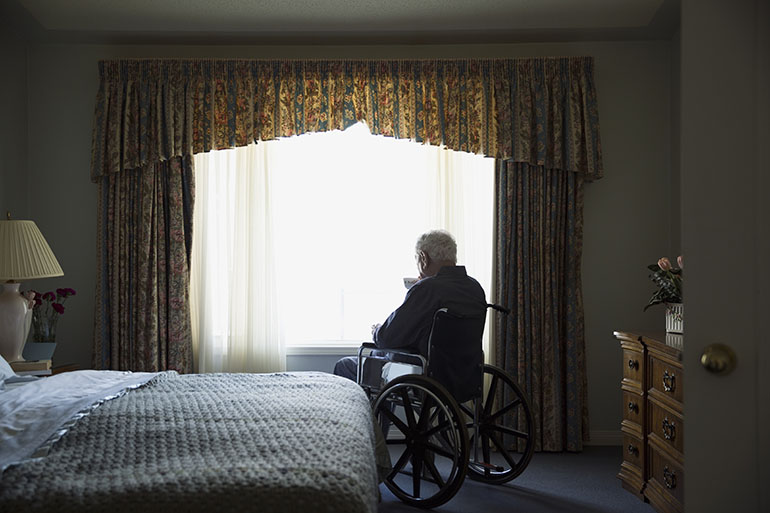It’s widely believed that older age is darkened by persistent loneliness. But a considerable body of research confirms this isn’t the case.
In fact, loneliness is the exception rather than the rule in later life. And when it occurs, it can be alleviated: It’s a mutable psychological state.
Only 30 percent of older adults feel lonely fairly frequently, according to data from the National Social Life, Health and Aging Project, the most definitive study of seniors’ social circumstances and their health in the U.S.
The remaining 70 percent have enough fulfilling interactions with other people to meet their fundamental social and emotional needs
 NAVIGATING AGING
NAVIGATING AGING“If anything, the intensity of loneliness decreases from young adulthood through middle age and doesn’t become intense again until the oldest old age,” said Louise Hawkley, an internationally recognized authority on the topic and senior research scientist at the National Opinion Research Center (NORC) at the University of Chicago.
Understanding the extent of loneliness is important, insofar as this condition has been linked to elevated stress, impaired immune system function, inflammation, high blood pressure, depression, cognitive dysfunction and an earlier-than-expected death in older adults.
A new study, co-authored by Hawkley, highlights another underappreciated feature of this affliction: Loneliness is often transient, not permanent.
That study examined more than 2,200 Americans ages 57 to 85 in 2005 and again in 2010. Of the group who reported being lonely in 2005 (just under one-third of the sample), 40 percent had recovered from that state five years later while 60 percent were still lonely.
What helped older adults who had been lonely recover? Two factors: spending time with other people and eliminating discord and disturbances in family relationships.
Hawkley explains the result by noting that loneliness is a signal that an essential need — a desire for belonging — isn’t being met. Like hunger or thirst, it motivates people to act, and it’s likely that seniors reached out to the people they were closest to more often.
Her study also looked at protective factors that kept seniors from becoming lonely. What made a difference? Lots of support from family members and fewer physical problems that interfere with an individual’s independence and ability to get out and about.
To alleviate loneliness, one must first recognize the perceptions underlying the emotion, Hawkley and other experts said.
The fundamental perception is one of inadequacy. People who are lonely tend to feel that others aren’t meeting their expectations and that something essential is missing. And there’s usually a significant gap between the relationships these people want and those they actually have.
This isn’t the same as social isolation — a lack of contact with other people — although the two can be linked. People can be “lonely in a marriage” that’s characterized by conflict or “lonely in a crowd” when they’re surrounded by other people with whom they can’t connect.
Interventions to address loneliness have received heightened attention since 2011, when the Campaign to End Loneliness launched in Britain.
Here are two essential ways to mitigate this distressing sentiment:
Alter perceptions. Loneliness perpetuates itself through a gloomy feedback cycle. We think people don’t like us, so we convey negativity in their presence, which causes them to withdraw from us, which reinforces our perception that we’re not valued.
Changing the perceptions that underlie this cycle is the most effective way to relieve loneliness, according to a comprehensive evaluation of loneliness interventions published in 2011.
Heidi Grant, associate director of the Motivation Science Center at Columbia University, described this dynamic in an article published in 2010. “If co-worker Bob seems more quiet and distant than usual lately, a lonely person is likely to assume that he’s done something to offend Bob, or that Bob is intentionally giving him the cold shoulder,” she wrote.
With help, people can learn to examine the assumptions underlying their thoughts and ask questions such as “Am I sure Bob doesn’t like me? Could there be other, more likely reasons for his quiet, reserved behavior at work?”
This kind of “cognitive restructuring” is an essential component of LISTEN, a promising intervention to treat loneliness developed by Laurie Theeke, an associate professor in the school of nursing at West Virginia University. In five two-hour sessions, small groups of lonely people probe their expectations of relationships, their needs, their thought patterns and their behaviors while telling their stories and listening to others.
Joining a group can be effective if there’s an educational component and people are actively engaged, experts said.
Invest in relationships. With loneliness, it’s not the quantity of relationships that counts most. It’s the quality.
If you’re married, your relationship with your spouse is critically important in sustaining a feeling of belonging and preventing loneliness, Hawkley said.
If you haven’t been getting along, it’s time to try to turn things around. Remember when you felt most connected to your spouse? How did that feel? Can you emphasize the positive and minimize the negative? If you’re badly stuck, seek professional help.
Investing in relationships with family members and friends is similarly important. This is the time to move beyond old grievances.
“If you want to recover from loneliness, try to deal with difficulties that are disrupting relationships,” Hawkley said.
Also, it’s a good idea to diversify your relationships so you’re not depending exclusively on a few people, according to Jenny de Jong Gierveld and Tineke Fokkema, loneliness researchers from the Netherlands.
Training in social skills can help lonely people deal with problems such as not knowing how to renew contact with an old friend or initiate conversation with a distant relative. And learning coping strategies can enlarge their arsenal of adaptive responses.
Both of these strategies are part of a six-week “friendship enrichment program” developed in the Netherlands. The goal is to help people become aware of their social needs, reflect on their expectations, analyze and improve the quality of existing relationships and develop new friendships.
One simple strategy can make a difference. “If you have good news, share it,” Hawkley said, “because that tends to bring people closer together.”
KHN’s coverage related to aging & improving care of older adults is supported by The John A. Hartford Foundation.







